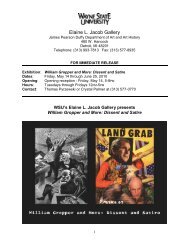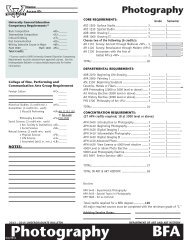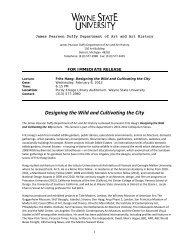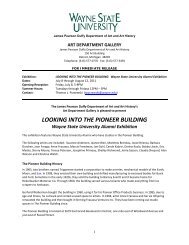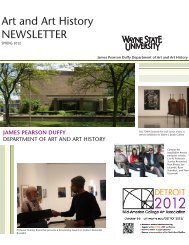linked - Department of Art and Art History - Wayne State University
linked - Department of Art and Art History - Wayne State University
linked - Department of Art and Art History - Wayne State University
You also want an ePaper? Increase the reach of your titles
YUMPU automatically turns print PDFs into web optimized ePapers that Google loves.
Lauren Kalman, <strong>Wayne</strong> <strong>State</strong> <strong>University</strong><br />
Evan Larsen, <strong>Wayne</strong> <strong>State</strong> <strong>University</strong><br />
Phil Renato, Kendall College <strong>of</strong> <strong>Art</strong> <strong>and</strong> Design<br />
Beverly Seley, Gr<strong>and</strong> Valley <strong>State</strong> <strong>University</strong><br />
Teaching the Elusive Skill Set: Concept <strong>and</strong> Content<br />
Friday, October 5, 8:00 AM – 9:30 AM<br />
Founders B, Level Three, Westin Book Cadillac Hotel<br />
Chairs: Zark (Peter) Strasburger, Memphis College <strong>of</strong> <strong>Art</strong><br />
Le<strong>and</strong>ra Urrutia, Memphis College <strong>of</strong> <strong>Art</strong><br />
The boundaries <strong>of</strong> what art <strong>and</strong> design curricula cover exp<strong>and</strong> with the scope <strong>of</strong> contemporary art.<br />
Content <strong>and</strong> concept are now as important as craft <strong>and</strong> technique have been traditionally. An<br />
emerging challenge for art educators is to teach idea development with the depth, breadth, <strong>and</strong><br />
comprehensibility that one teaches the craft <strong>and</strong> technique <strong>of</strong> specific media. The physical skills<br />
associated with making work in a particular material or with a certain technical process seem more<br />
concrete <strong>and</strong> underst<strong>and</strong>able than the cognitive <strong>and</strong> temporal skills <strong>and</strong> methods associated with<br />
idea development. This differential is likely based on the observability <strong>of</strong> processes <strong>of</strong> the h<strong>and</strong> <strong>and</strong> the<br />
relative invisibility <strong>of</strong> mental <strong>and</strong> emotional process. How can we effectively teach students to craft<br />
with great facility in this less tangible realm <strong>of</strong> ideas <strong>and</strong> creative content<br />
This panel <strong>of</strong> presenters will discuss strategies for developing <strong>and</strong> delivering concept development <strong>and</strong><br />
visual content communication coursework. How can we teach the more elusive, yet vital, artistic<br />
talents <strong>of</strong> communication through concept, content, <strong>and</strong> context The panel will investigate methods<br />
for teaching courses with the objective <strong>of</strong> building the foundational skills <strong>of</strong> creative concept<br />
development <strong>and</strong> visual content communication in a studio art setting. The panel will <strong>of</strong>fer insight<br />
into the following two questions:<br />
1) What things should one consider when developing coursework for teaching rich content<br />
development<br />
2) In a post media centric course format, how can we meaningfully evaluate quantity <strong>and</strong> quality <strong>of</strong><br />
communication in student work<br />
Panelists:<br />
Chris Yates, Columbus College <strong>of</strong> <strong>Art</strong> <strong>and</strong> Design<br />
Jesse Payne, Virginia Commonwealth <strong>University</strong> in Qatar, Doha, Qatar<br />
Amy Vogel, School <strong>of</strong> the <strong>Art</strong> Institute <strong>of</strong> Chicago<br />
Brian Sikes, School <strong>of</strong> the <strong>Art</strong> Institute <strong>of</strong> Chicago




